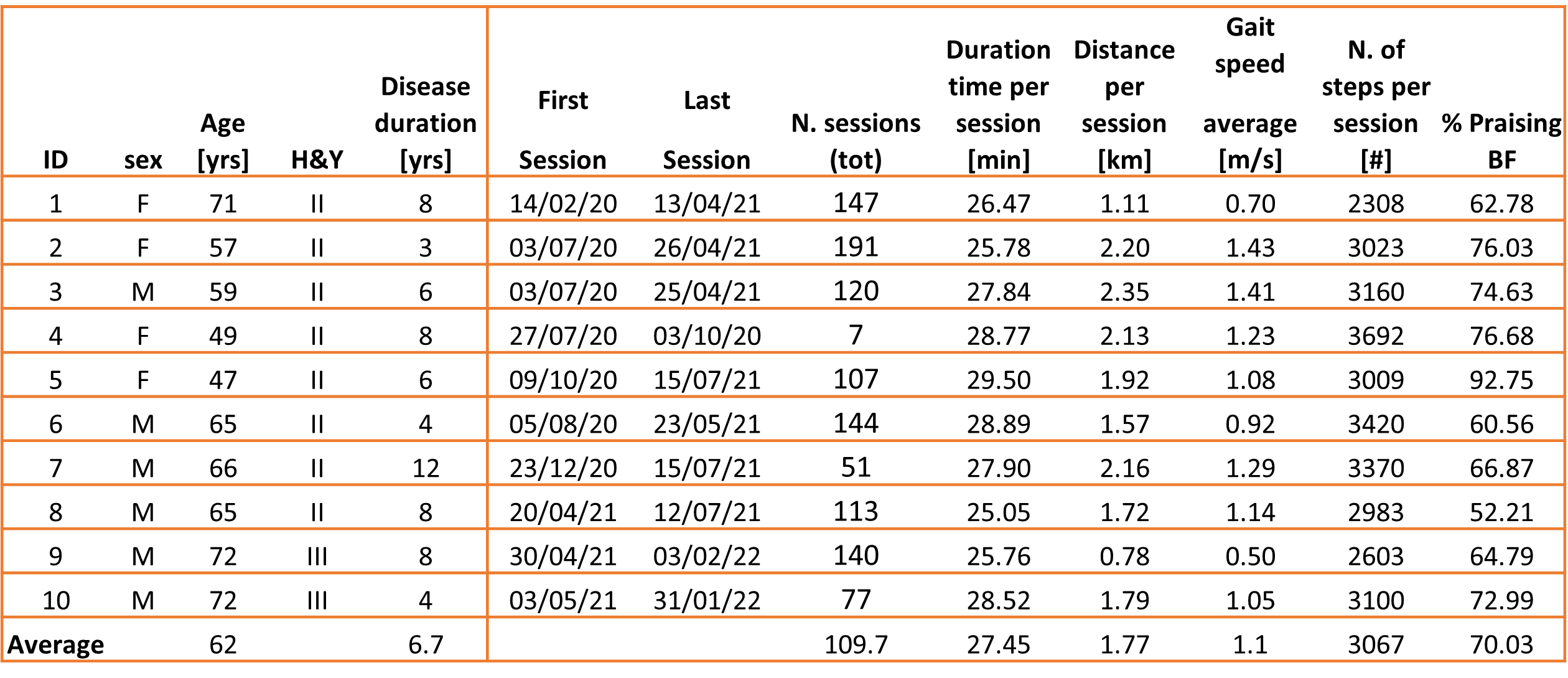Category: Technology
Objective: This study aims to evaluate the feasibility of long-term wearable tele-rehabilitation of gait in people with Parkinson’s disease.
Background: Tele-rehabilitation allows patients to utilize rehabilitation services at home. The novel tele-rehabilitation system tested in this study is an innovative wearable device (smartphone + 2 IMUs on the shoes + 1 IMU on the chest), developed to provide gait training to people with Parkinson’s Disease (PD) in the real world, outside of specialized centers. In a previous pilot randomized control trial (CuPiD), 20 patients with PD used the system for 6 weeks without adverse side effects [1,2]. Based on these initial results, we aim here to assess the feasibility a long-term gait training program of 9-months.
Method: Twenty patients with PD (10 in Italy and 10 in Israel) were recruited to perform gait training at home in their ON medication state for 30 minutes, 3 times/week for 9-months using the tele-rehabilitation system. It provides real-time audio feedback (e.g., “take longer steps” or “walk faster”) to users based on the locomotor patterns evaluated by the IMUs to correct or reinforce their gait behavior. We report a preliminary analysis of the data collected from the Italian site. Clinical information about the analyzed participants is in Table 1.
Results: There was a single drop-out. As seen in Table 1, the other nine subjects could finish the rehabilitation program. The participants had an average of 27.45 minutes, 1.77 km walked, and 1.1 m/s gait speed per exercise session. The percentage of praising audio feedbacks (e.g., “good work”), which corresponds to the patient correctly following the instructions provided by the digital assistant, was 70% on average, showing correct and effective use of the system by the patients.
Conclusion: For the first time, the present work shows the feasibility of long-term digitally-assisted gait training in PD, giving preliminary evidence that it is possible to provide remote gait rehabilitation sessions for people with PD over an extended period of time. Further evaluation of the second cohort will provide more results about this digital rehabilitation program’s feasibility and efficacy.
This research was realized with the contribution of Ministero degli Affari Esteri e della Cooperazione Internazionale.
References: [1] Ginis P, Nieuwboer A, Dorfman M, Ferrari A, Gazit E, Canning CG, Rocchi L, Chiari L, Hausdorff JM, Mirelman A. Feasibility and effects of home-based smartphone-delivered automated feedback training for gait in people with Parkinson’s disease: A pilot randomized controlled trial. Parkinsonism Relat Disord (2016) 22:28–34. doi:10.1016/J.PARKRELDIS.2015.11.004
[2] Ferrari A, Ginis P, Hardegger M, Casamassima F, Rocchi L, Chiari L. A Mobile Kalman-Filter Based Solution for the Real-Time Estimation of Spatio-Temporal Gait Parameters. IEEE Trans Neural Syst Rehabil Eng (2016) 24:764–773. doi:10.1109/TNSRE.2015.2457511
To cite this abstract in AMA style:
G. Lopane, M. Corzani, I. D'Ascanio, V. Petrone, M. Contin, G. Calandra Buonaura, P. Cortelli, F. La Porta, M. Brozgol, N. Giladi, PC. Thumm, JM. Hausdorff, L. Chiari, L. Palmerini. Long-term wearable tele-rehabilitation of gait for persons with Parkinson’s disease: A feasibility study [abstract]. Mov Disord. 2022; 37 (suppl 2). https://www.mdsabstracts.org/abstract/long-term-wearable-tele-rehabilitation-of-gait-for-persons-with-parkinsons-disease-a-feasibility-study/. Accessed April 28, 2025.« Back to 2022 International Congress
MDS Abstracts - https://www.mdsabstracts.org/abstract/long-term-wearable-tele-rehabilitation-of-gait-for-persons-with-parkinsons-disease-a-feasibility-study/

